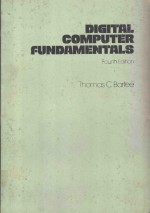图书介绍
DIGITAL COMPUTER FUNDAMENTALSPDF|Epub|txt|kindle电子书版本下载

- THOMAS C. BARTEE 著
- 出版社: MCGRAW-HILL
- ISBN:0070038929
- 出版时间:1977
- 标注页数:563页
- 文件大小:61MB
- 文件页数:575页
- 主题词:
PDF下载
下载说明
DIGITAL COMPUTER FUNDAMENTALSPDF格式电子书版下载
下载的文件为RAR压缩包。需要使用解压软件进行解压得到PDF格式图书。建议使用BT下载工具Free Download Manager进行下载,简称FDM(免费,没有广告,支持多平台)。本站资源全部打包为BT种子。所以需要使用专业的BT下载软件进行下载。如BitComet qBittorrent uTorrent等BT下载工具。迅雷目前由于本站不是热门资源。不推荐使用!后期资源热门了。安装了迅雷也可以迅雷进行下载!
(文件页数 要大于 标注页数,上中下等多册电子书除外)
注意:本站所有压缩包均有解压码: 点击下载压缩包解压工具
图书目录
1 COMPUTER OPERATION1
1.1 Calculators and Computers2
1.2 Differences between Desk Calculators and Computers4
1.3 Electronic Digital Computers4
1.4 Application of Computers to Problems6
1.5 Applications of Computers in Business8
1.6 Scientific Applications9
1.7 Some Different Types of Computer Systems11
1.8 The Use of Digital Computers in Control Systems14
1.9 Special-Purpose and General-Purpose Computers16
1.10 Time-shared Computer Systems17
1.11 Basic Components of a Digital Computer18
1.12 Construction of Memory20
1.13 Instructions20
1.14 Multiplication Instruction23
1.15 BRANCH,SKIP,or JUMP Instructions25
1.16 Reading the Program into the Computer26
1.17 Programming Systems33
1.18 Assembly Languages34
1.19 Compiler Languages37
1.20 A Short Introduction to PL/138
Questions42
2 NUMBER SYSTEMS47
2.1 The Decimal System48
2.2 The Binary System49
2.3 Counting in the Binary System49
2.4 Binary Addition and Subtraction51
2.5 Binary Multiplication and Division51
2.6 Converting Decimal Numbers to Binary53
2.7 Negative Numbers54
2.8 The Use of Complements to Represent Negative Numbers56
2.9 Complements in Other Number Systems57
2.10 Binary Number Complements57
2.11 Binary-coded-decimal Number Representation58
2.12 Octal and Hexadecimal Number Systems61
Questions65
3 BOOLEAN ALGEBRA AND GATE NETWORKS73
3.1 Fundamental Concepts of Boolean Algebra74
3.2 Logical Multiplication75
3.3 OR Gates and AND Gates76
3.4 Complementation and Inverters78
3.5 Evaluation of Logical Expressions79
3.6 Evaluation of an Expression Containing Parentheses80
3.7 Basic Laws of Boolean Algebra82
3.8 Proof by Perfect Induction84
3.9 Simplification of Expressions86
3.10 De Morgan’s Theorems86
3.11 Basic Duality of Boolean Algebra87
3.12 Derivation of a Boolean Expression87
3.13 Combination of Gates91
3.14 Sum-of-Products and Product-of-Sums92
3.15 Derivation of Product-of-Sums Expressions94
3.16 Derivation of a Three-Input-Variable Expression95
3.17 NAND Gates and NOR Gates97
3.18 The Map Method for Simplifying Expressions100
3.19 Subcubes and Covering103
3.20 Product-of-Sums Expressions-Don’t-cares108
Questions110
4 LOGICAL DESIGN124
4.1 The Flip-Flop125
4.2 The Transfer127
4.3 The Clock128
4.4 The Shift Register131
4.5 The Binary Counter132
4.6 BCD Counters138
4.7 Integrated Circuits139
4.8 Medium- and Large-Scale Integration148
4.9 Gated Flip-Flop Designs.152
4.10 The Gated Flip-Flop152
4.11 The Master-Slave Flip-Flop154
4.12 Counter Design157
Questions161
5 DIGITAL CIRCUITS168
5.1 Computer Circuits169
5.2 Characteristics of Diodes and Transistors Used in Switching Circuits169
5.3 The Emitter Follower177
5.4 The AND Gate178
5.5 The Diode AND Circuit179
5.6 The OR Gate180
5.7 The Inverter Circuit181
5.8 NOR Gates184
5.9 The Transistor Flip-Flop186
5.10 Resistor-Transistor Logic187
5.11 Diode-Transistor Logic189
5.12 Transistor-Transistor Logic191
5.13 Emitter-coupled Logic198
5.14 Metal-Oxide Semiconductor Circuits202
5.15 CMOS Logic Circuits206
Questions209
6 THE ARITHMETIC-LOGIC UNIT219
6.1 Construction of the ALU220
6.2 Integer Representation221
6.3 The Binary Half Adder222
6.4 The Full Adder223
6.5 A Parallel Binary Adder224
6.6 Positive and Negative Numbers227
6.7 Addition in the 1 s Complement System228
6.8 Addition in the 2s Complement System229
6.9 Addition and Subtraction in a Parallel Arithmetic Element231
6.10 The Full Adder234
6.11 The Binary-Coded-Decimal (BCD) Adder237
6.12 Positive and Negative BCD Numbers239
6.13 Addition and Subtraction in the 9s Complement System241
6.14 The SHIFT Operation245
6.15 Basic Operations246
6.16 Binary Multiplication250
6.17 Decimal Multiplication253
6.18 Division254
6.19 Logical Operations260
6.20 Floating-Point Number Systems262
6.21 Performing Arithmetic Operations with Floating-Point Numbers267
Questions268
7 THE MEMORY ELEMENT274
7.1 Random-Access Memories276
7.2 Magnetic Core Storage278
7.3 Storage of Information in Magnetic Cores in a Two-dimensional Array281
7.4 Assembly of Core Planes into a Core Memory285
7.5 Timing Sequence287
7.6 Characteristics of Core-Memory Array289
7.7 Memory Address and Memory Buffer Registers289
7.8 Driving the X- and Y-Selection Lines290
7.9 Memory Buffer Register and Associated Circuitry292
7.10 Characteristics of Core Memory294
7.11 Decoders295
7.12 Core-Memory Organization and Wiring Schemes300
7.13 Random-Access Semiconductor Memories304
7.14 Bipolar IC Memories305
7.15 Static MOS Memories308
7.16 Dynamic Memories314
7.17 Read-only Memories316
7.18 Magnetic Drum Storage321
7.19 Parallel and Serial Operation of a Magnetic Drum325
7.20 Magnetic Disk Memories327
7.21 Flexible Disk Storage Systems-The Floppy Disk332
7.22 Magnetic Tape336
7.23 Tape Cassettes and Cartridges340
7.24 Digital Recording Techniques346
7.25 Return-to-Zero and Return-to-Bias Recprding Techniques346
7.26 Non-Return-to-Zero Recording Techniques349
Questions351
8 INPUT-OUTPUT DEVICES357
8.1 Differences in Business and Scientific Uses358
8.2 Perforated Tape359
8.3 Tape Readers362
8.4 Punched Cards365
8.5 Card Readers367
8.6 Alphanumeric Codes369
8.7 Data Preparation373
8.8 Character Recognition374
8.9 Output Equipment376
8.10 Printers377
8.11 Cathode-Ray-Tube Output Devices382
8.12 Other Output Devices384
8.13 Error-detecting and Error-correcting Codes385
8.14 Terminals387
8.15 Input-Output Devices for Systems with Analog Components391
8.16 Analog-to-Digital Converters-Shaft Encoders392
8.17 Digital-to-Analog Converters394
8.18 Electronic High-Speed Analog-to-Digital Converters395
Questions399
9 THE CONTROL UNIT405
9.1 Construction of Instruction Word406
9.2 Instruction-Cycle and Execution-Cycle Organization of Control Registers412
9.3 Sequence of Operation of Control Registers415
9.4 Controlling Arithmetic Operations417
9.5 Typical Sequence of Operations424
9.6 BRANCH,SKIP,or JUMP Instructions426
9.7 SHIFT Instructions429
9.8 Microprogramming432
9.9 Variations in Microprogramming Configurations438
Questions440
10 COMPUTER ORGANIZATION443
10.1 Instruction Word Formats-Number of Addresses444
10.2 Representation of Instructions and Data448
10.3 Addressing Techniques449
10.4 Index Registers449
10.5 Paging and Indirect Addressing451
10.6 Interconnecting System Components455
10.7 Interfacing-Buses463
10.8 Microprocessors and Microcomputers470
10.9 Single-Address Computer Organization481
10.10 A Single-Address Microprocessor488
10.11 Two-Address Computers500
10.12 IBM 360/370 Computer Series506
Questions513
BIBLIOGRAPHY521
ANSWERS TO SELECTED ODD-NUMBERED QUESTIONS527
INDEX552